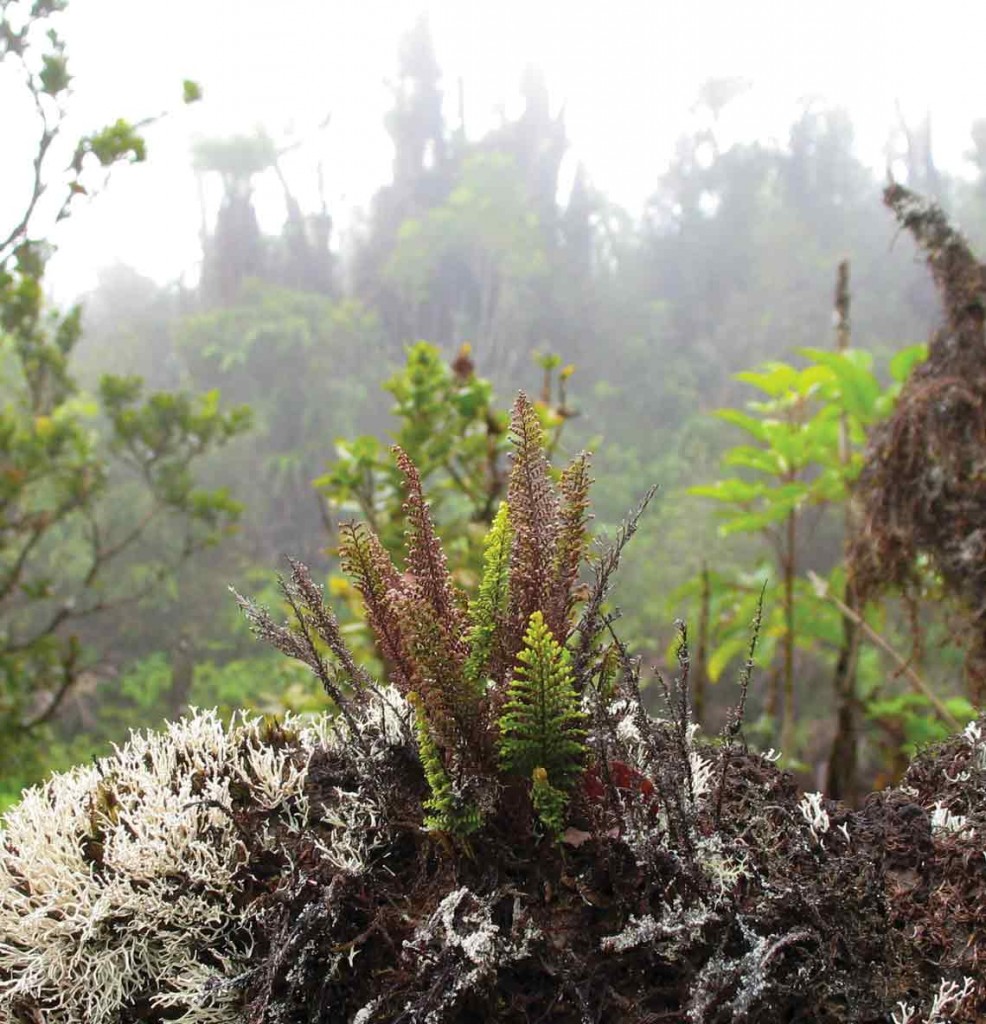Big Bog, high above Hāna on the windward slopes of East Maui, and Puʻu Kukui, on West Maui are some of the wettest places on the earth with 360-400 inches of rainfall a year, so it’s hard to imagine water could ever run short. When overrun with water, it’s easy not to think about times of scarcity, much like the flow of money. Knowing now how much, when, where the dollars are coming from helps, as does prioritizing needs versus luxuries. If needs exceed income, we can earn more, spend less, or combine the two approaches.

Near the summit of Puʻu Kukui on West Maui clouds are the norm. The rain that falls here and on the slopes of Haleakalā supplies Maui residents and visitors throughout the year.
The same is true for managing our limited water resources. Studies in Hawaiʻi are looking to see how what happens in our forests affects what comes out of our faucets.

Stream runoff is captured from East Maui to meet the needs of upcountry residents and agriculture.
Hydrologists develop water “budgets” to quantify how water moves through our environment and how much is captured for our use. They look at all the drops that go into and out of the watershed, whether in by rainfall and fog drip or out by runoff and evaporation. Sometimes water goes into the savings account – absorbed by the soil, then into the water table or aquifer through infiltration and recharge. On Maui, the water we use is either captured from surface runoff or pumped from the aquifer.
The Maui County Department of Water Supply tracks overall water use while striving to meet the needs of the community. Understanding hydrological cycles and water budgets, helps the Department plan for the future by looking at how to capture more water from the sky or spend less through runoff and evaporation to meet the needs of tomorrow. But how? Many factors influence water budgets. Research done on the mainland might not be relevant for Hawaiʻi, a comparatively tiny sprinkling of islands in the middle of a massive ocean. So the Department is working with the U.S. Geological Survey to study water systems on Maui to help prepare for the future.

The plants in a native Hawaiian forest effectively capture more water than many of the invasive plants that make up the lower elevation forests.
Differences in land cover and use affect hydrological processes, including whether native or non-native plants rule our forests. The drip-drip of water, condensing and falling from plants, is a critical source of moisture; it can easily make up 20% of the total water collected. On Lānaʻihale (the forested top of Lānaʻi), fog drip accounts for a whopping 60-80% of water input. Cook pines were planted on the island because of their impressive ability to capture fog drip, but native plants may do better. One study in forests on Hawaiʻi Island showed that 27% of the total precipitation was collected as fog drip in an ʻōhiʻa-dominated forest, but that number decreased to 16% where a forest had been invaded by strawberry guava.
Not all water that falls from the heavens makes it into the aquifer. Soil in a forest absorbs more water, and does so more quickly, than soil in nearby fields, pastures, or grassland. Forests transformed into monotypic stands of miconia plants typically have bare soil which likely captures less moisture. Water also evaporates into the atmosphere from the ground and off leaf surfaces, but the rate varies for different species. Research has shown that non-native plants release more water into the atmosphere than our native ʻōhiʻa.
One study on Hawaiʻi Island found that restoring a forest dominated by invasive trees to a native forest increased aquifer recharge. But results aren’t always consistent. A restoration project on Molokaʻi actually yielded a slight decrease in recharge. Given the complexities of our forest systems and the number of changes humans have caused over the years, it’s clear there are many mysteries yet to unravel about water systems in Hawaiʻi.
We do know that overall demand for water will only increase. Over time, so too will our understanding of how to preserve or restore healthy forests to help ensure we will have the amount of water we need, now and for future generations.
Find more information about how water cycles through forests in Hawaiʻi and on Maui including a water-budget model. You can also find tips on stretching your water budget at home on the County of Maui – Department of Water Supply’s website.
Lissa Strohecker is the public relations and education specialist for the Maui Invasive Species Committee. She holds a biological sciences degree from Montana State University. Kia’i Moku, “Guarding the Island,” is prepared by the Maui Invasive Species Committee to provide information on protecting the island from invasive plants and animals that can threaten the island’s environment, economy and quality of life.
Originally published in the Maui News, July 14th, 2015 as part of the Kia‘i Moku Column from the Maui Invasive Species Committee.




